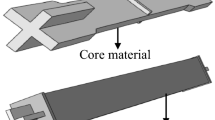Abstract
The aim of this study was assessing the seismic performance of three types of mid-span connections in the cross bracing systems including: the mid-span connection with cover plates, the flanged connections and the braced ductile shear panel (BDSP). For this purpose, the linear buckling and post-buckling behavior of the cross braces with the aforementioned connections having nonlinear geometries and materials were numerically analyzed. The results were compared to the results of the common connection. According to the results, use of the cross braces with mid-span connection together with cover plates and flanged connections due to creating continuity in the mid-span connection, cause coordinated buckling of the discontinuous diagonal members (or so-called second mode buckling) and thereby improved compression performance of the cross braces. In addition, use of the ductile shear panel in the mid-span connection led to more energy dissipation by cross braces and prevented buckling of the diagonal bracing members.












Similar content being viewed by others
References
Alipour, M., & Aghakouchak, A. A. (2013). Numerical analysis of the nonlinear performance of concentrically braced frames under cyclic loading. International Journal of Steel Structures, Springer, 13(3), 401–419.
ANSI/AISC 360-10. (2010). Specification for structural steel buildings. Chicago-Illinois: American Institute of Steel Construction.
Davaran, A. (2001). Effective length factor for discontinuous X-bracing systems. Journal of engineering mechanics, American Society of Civil Engineers, 127(2), 106–112.
Davaran, A., & Hoveidae, N. (2009). Effect of mid-connection detail on the behavior of X-bracing systems. Journal of Constructional Steel Research, 65(4), 985–990.
Deshpande, S. (2011). Buckling and Post buckling of structural components. A thesis submitted in partial fulfillment of the MS degree. Arlington: University of Texas.
Di Sarno, L., & Elnashai, A. S. (2009). Bracing systems for seismic retrofitting of steel frames. Journal of Constructional Steel Research, 65(2), 452–465.
Elnashai, A. S., & Di Sarno, L. (2008). Fundamentals of earthquake engineering. London: Wiley.
EN 1993-1-1. (2005). Eurocode 3: Design of steel structures—Part 1-1: General rules and rules for buildings. Brussels: European Committee for Standardisation.
Fang, C., Yam, M. C. H., Zhou, X., & Zhang, Y. (2015). Post-buckling resistance of gusset plate connections: Behaviour, strength, and design considerations. Engineering Structures, 99, 9–27.
Giannuzzi, D., Ballarini, R., Huckelbridge, A., Jr., Pollino, M., & Valente, M. (2013). Braced ductile shear panel: New seismic-resistant framing system. Journal of Structural Engineering, American Society of Civil Engineers, 140(2), 4013050.
Krawinkler, H. (1992). Guidelines for cyclic seismic testing of components of steel structures. ATC-24, Applied Technology Council.
Mahmoudi, M., & Zaree, M. (2010). Evaluating response modification factors of concentrically braced steel frames. Journal of Constructional Steel Research, 66(10), 1196–1204.
Moon, J., Yoon, K. Y., Han, T. S., & Lee, H. E. (2008). Out-of-plane buckling and design of X-bracing systems with discontinuous diagonals. Journal of Constructional Steel Research, 64(3), 285–294.
Palmer, K. D., Roeder, C. W., Lehman, D. E., Okazaki, T., Shield, C. K., & Powell, J. (2012). Concentric X-braced frames with HSS bracing. International Journal of Steel Structures, Springer, 12(3), 443–459.
Sabelli, R., Roeder, C. W., & Hajjar, J. F. (2013). Seismic design of steel special concentrically braced frame systems. NEHRP, Gaithersburg, USA, Seismic Design Technical Brief, 8.
Segal, F., Levy, R., & Rutenberg, A. (1994). Design of imperfect cross-bracings. Journal of engineering mechanics, American Society of Civil Engineers, 120(5), 1057–1075.
Simulia, D. S. (2013). ABAQUS 6.13 user’s manual, Abaqus User’s Guide. Providence, RI: Dassault Systems.
Stoman, S. H. (1988). Stability criteria for X-bracing systems. Journal of engineering mechanics, American Society of Civil Engineers, 114(8), 1426–1434.
Stoman, S. H. (1989). Effective length spectra for cross bracings. Journal of Structural Engineering, American Society of Civil Engineers, 115(12), 3112–3122.
Thornton, W. A. (1984). Bracing connections for heavy construction. Engineering Journal, AISC, 21(3), 139–148.
Uang, C. M., Bruneau, M., Whittaker, A. S., & Tsai, K. C. (2001). Seismic design of steel structures. In F. Naeim (Ed.), The seismic design handbook (pp. 409–462). Boston, MA: Springer.
Wang, D. Q., & Boresi, A. P. (1992). Theoretical study of stability criteria for X-bracing systems. Journal of engineering mechanics, American Society of Civil Engineers, 118(7), 1357–1364.
Whitmore, R. E. (1952). Experimental investigation of stresses in gusset plates. Engineering Experiment Station. Knoxville: University of Tennessee.
Yam, M. C. H., & Cheng, J. J. R. (1993). Experimental investigation of the compressive behavior of gusset plate connections. Alberta: University of Alberta, Department of Civil Engineering.
Yoo, C. H., & Lee, S. (2011). Stability of structures: Principles and applications. Amsterdam: Elsevier.
Yoo, J. H., Lehman, D. E., & Roeder, C. W. (2008). Influence of connection design parameters on the seismic performance of braced frames. Journal of Constructional Steel Research, 64(6), 607–623.
Author information
Authors and Affiliations
Corresponding author
Rights and permissions
About this article
Cite this article
Mahmoudi, M., Shirpour, A. & Zarezadeh, A. The Effects of Mid-Span Connection Specifications on Compressive Performance of Cross (X) Braces. Int J Steel Struct 19, 1125–1133 (2019). https://doi.org/10.1007/s13296-018-0192-x
Received:
Accepted:
Published:
Issue Date:
DOI: https://doi.org/10.1007/s13296-018-0192-x




